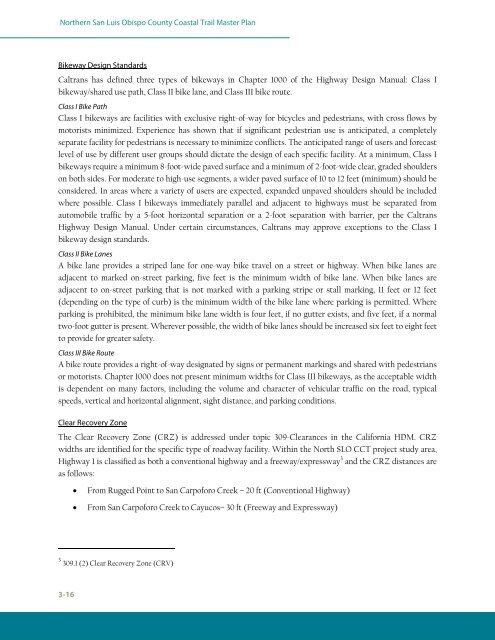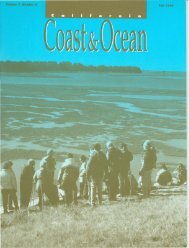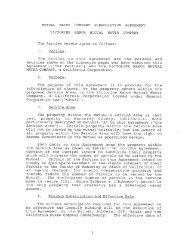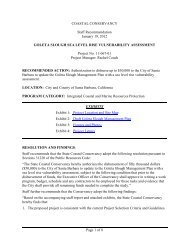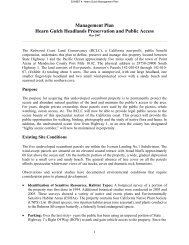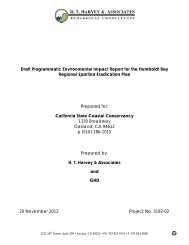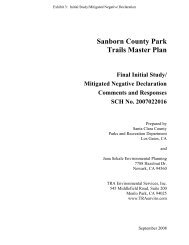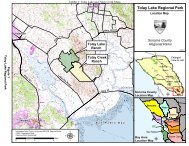Northern San Luis Obispo County Coastal Trail Master Plan
Northern San Luis Obispo County Coastal Trail Master Plan
Northern San Luis Obispo County Coastal Trail Master Plan
Create successful ePaper yourself
Turn your PDF publications into a flip-book with our unique Google optimized e-Paper software.
<strong>Northern</strong> <strong>San</strong> <strong>Luis</strong> <strong>Obispo</strong> <strong>County</strong> <strong>Coastal</strong> <strong>Trail</strong> <strong>Master</strong> <strong>Plan</strong><br />
Bikeway Design Standards<br />
Caltrans has defined three types of bikeways in Chapter 1000 of the Highway Design Manual: Class I<br />
bikeway/shared use path, Class II bike lane, and Class III bike route.<br />
Class I Bike Path<br />
Class I bikeways are facilities with exclusive right-of-way for bicycles and pedestrians, with cross flows by<br />
motorists minimized. Experience has shown that if significant pedestrian use is anticipated, a completely<br />
separate facility for pedestrians is necessary to minimize conflicts. The anticipated range of users and forecast<br />
level of use by different user groups should dictate the design of each specific facility. At a minimum, Class I<br />
bikeways require a minimum 8-foot-wide paved surface and a minimum of 2-foot-wide clear, graded shoulders<br />
on both sides. For moderate to high-use segments, a wider paved surface of 10 to 12 feet (minimum) should be<br />
considered. In areas where a variety of users are expected, expanded unpaved shoulders should be included<br />
where possible. Class I bikeways immediately parallel and adjacent to highways must be separated from<br />
automobile traffic by a 5-foot horizontal separation or a 2-foot separation with barrier, per the Caltrans<br />
Highway Design Manual. Under certain circumstances, Caltrans may approve exceptions to the Class I<br />
bikeway design standards.<br />
Class II Bike Lanes<br />
A bike lane provides a striped lane for one-way bike travel on a street or highway. When bike lanes are<br />
adjacent to marked on-street parking, five feet is the minimum width of bike lane. When bike lanes are<br />
adjacent to on-street parking that is not marked with a parking stripe or stall marking, 11 feet or 12 feet<br />
(depending on the type of curb) is the minimum width of the bike lane where parking is permitted. Where<br />
parking is prohibited, the minimum bike lane width is four feet, if no gutter exists, and five feet, if a normal<br />
two-foot gutter is present. Wherever possible, the width of bike lanes should be increased six feet to eight feet<br />
to provide for greater safety.<br />
Class III Bike Route<br />
A bike route provides a right-of-way designated by signs or permanent markings and shared with pedestrians<br />
or motorists. Chapter 1000 does not present minimum widths for Class III bikeways, as the acceptable width<br />
is dependent on many factors, including the volume and character of vehicular traffic on the road, typical<br />
speeds, vertical and horizontal alignment, sight distance, and parking conditions.<br />
Clear Recovery Zone<br />
The Clear Recovery Zone (CRZ) is addressed under topic 309-Clearances in the California HDM. CRZ<br />
widths are identified for the specific type of roadway facility. Within the North SLO CCT project study area,<br />
Highway 1 is classified as both a conventional highway and a freeway/expressway 3 and the CRZ distances are<br />
as follows:<br />
3-16<br />
� From Rugged Point to <strong>San</strong> Carpoforo Creek – 20 ft (Conventional Highway)<br />
� From <strong>San</strong> Carpoforo Creek to Cayucos– 30 ft (Freeway and Expressway)<br />
3 309.1 (2) Clear Recovery Zone (CRV)


